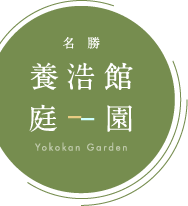An original design with a modeling technique that goes outside the traditional style of Japanese gardens
The spatial art features incorporated into the garden, which would even amaze modern artists, include the following: a pond without a central island, a sukiya-style building that hugs an expansive body of water, a stream that flows beautifully along the pebble shore, and a refined landscape.
The garden maintains the exact features noted in the Osensui Sashizu (Osensui’s original garden pond blueprint). These include the landscaping stones, the stone bridge, and the layout.

The Osensui Sashizu (Osensui’s original garden pond blueprint)(1823)
One of the attractions of this garden is the extraordinary waterscape

The current stream is narrower than the original. Water had been taken from the Shibahara channel, but nowadays, groundwater is being used. The tasteful pebble shore that remains is an extremely rare example of a unique design utilized since the Heian period.

Harumichi Kitawo.1936.Sukiya Jutaku-shu (Collection of Sukiya-style Homes).Tokyo:Soubunsya

Harumichi Kitawo.1936.Sukiya Jutaku-shu (Collection of Sukiya-style Homes).Tokyo:Soubunsya
The structure has the typical usage of a bridge. However stylistically, this natural stone bridge, which measures approximately 500 cm in length, 90 cm in width, and 50 cm in thickness, is uniquely different due to its close proximity to the water’s surface.

Near the unusual pebble shore are beautiful and locally-made stepping stones.

Light purple, rhyolite Anto stones

Pink biotite granite

A giant flat stone serving as the base for pillars has become a key sightseeing point for the garden. The stone also merges the curved outline of the beach with the straight outline of the flagstones on the edge of the pebble covered verandah. It is a good display of Yokokan Garden’s highly artistic qualities.

Harumichi Kitawo.1936.Sukiya Jutaku-shu (Collection of Sukiya-style Homes).Tokyo:Soubunsya
Since the garden’s creation, there has been a hole in the bottom of the shakudani stone wash basin (approximately 90 cm in outer diameter). It is believed that in the past, water sprang forth from the basin.


Currently, the south part (2m in width) of the Usu no otya ya’s foundation is underneath the existing road. Although only a section of the foundation remains, one can see the entire floor plan on the map.
A type of fine Echizen paper called mizutana orinokogami was affixed to a portion of the ceiling.
An arrangement of standing stones in a dynamic spatial design
If visitors look past the stone arrangement made of 2 columnar-joint pillars for which Tojinbo is famous, they can see that the building seems to be floating inside a water bubble.

The gazebo used for resting or for viewing the garden has also become a key scenic spot. There is a striking array of huge standing stones on the side of the jetty with the gazebo, which not only evokes the sensation of viewing the garden from a bridge, but also from a boat.


The garden was not built to accentuate the building, and the building was not just an attachment to the garden. The building and the garden were meant to complement each other, and blend in perfect harmony.

The water-conduit

Scenic view of a seven-storied stone pagoda

Scenic view of a seven-storied stone pagoda
The daruma-shaped rock island provides an accent to the landscape.





